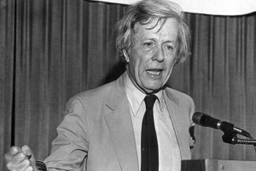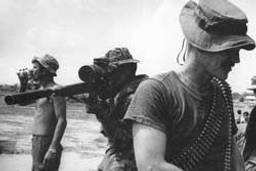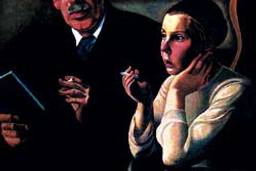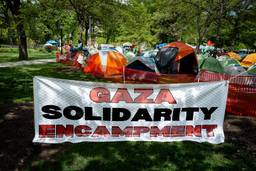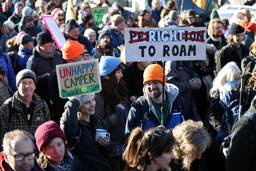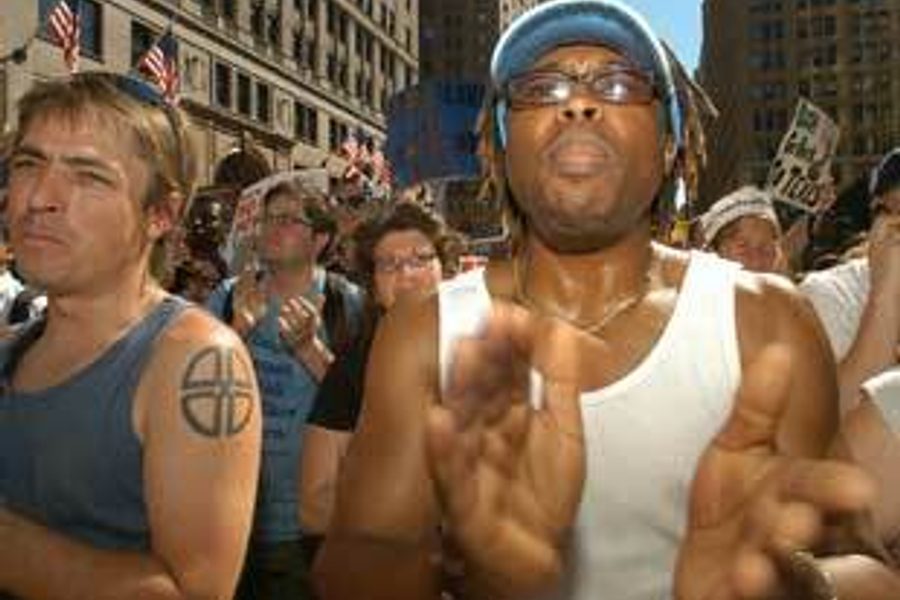
Politics, pundits and even the weather report seemed to be conspiring against a massive turnout at Sunday’s New York City demonstration against the Republican National Convention. Thanks to the city’s refusal to allow a rally in Central Park, no one knew until days earlier where the march would go or what would happen when it got there. Liberal commentators like Todd Gitlin and James Traub, trapped in nightmarish flashbacks of Chicago 1968, issued vague yet dire warnings about clashes with police. On top of it all, it seemed like it might thunderstorm.
But in the end, more than 500,000 people marched past Madison Square Garden on a sweltering, sunny August afternoon. United for Peace and Justice, the group organizing the march, wanted to build a truly massive protest appropriate for participants from kids to senior citizens, showcasing the breadth of opposition to the war in Iraq and the Bush administration’s social and economic policies, that contrasted with the smaller, more confrontational demonstrations planned for later in the week. They succeeded — building one of the largest protests in New York City history and the biggest ever at a political convention. Fox News reports of “tens of thousands” underestimated by a few hundred thousand, and not even the NYPD contested organizers’ claims that half a million people were there.
The giant, mostly peaceful demonstration will frame the many actions later in the week, making it clear that protesters reflect the beliefs of millions, not the radical fringe. What’s more, the fact that so many New Yorkers were willing to take to the streets against the lies, greed and unleashed corporate aggression the Bush administration stands for will make it very hard for his campaign to use the city as a passive backdrop for the glory of the commander in chief.
Sunday’s protest was testament to philosopher Carl Schmitt’s dictum that all politics needs an enemy. Irreverent, mocking hatred of Bush was the unifying theme of the day. “Somewhere in Texas there’s a village missing an ass,” read one sign, while another ordered, “Bush, Cheney: Take a Swift Boat Outta New York!” People carried flyswatters bearing W’s visage, and there were countless dirty jokes to the effect of “My Bush Knows Better” and “Bush + Dick = Screwed.” Bush was not the only target: When confronted with a giant Fox News billboard at the corner of 34th Street and Seventh Avenue, thousands joined in the chant, “Fox News Lies!”
The excitement of expressing political rage gave the protest the festive vibe of an urban street party. People were packed so tightly that it took six hours for the march to complete its route past Madison Square Garden. The Code Pink brigade, decked out in magenta boas and pastel gowns, danced to the raucous sound of bells and drums. Billionaires for Bush, wearing the top hats of the 19th Century industrialists and the smoking jackets of the 1920s nouveau riche, thanked passers-by for subsidizing their generous tax cuts. “Ban Republican Marriage,” one poster urged, while a “Suburban Mom for Regime Change” carried a poster depicting a steaming apple pie. Despite the outpouring of anger at Bush, the Kerry campaign should take note: This was unambiguously an antiwar march, and far more marchers proclaimed hatred for Bush than support for Kerry (although I did see one banner proclaiming, “I Love JFK”).
After dispersing at Union Square, thousands of demonstrators headed uptown to Central Park’s Great Lawn. Although the lawn was ringed with police, it quickly filled up with protesters relaxing on the soft green grass. There was no sound system at the park, and hence no speeches, but it was hard to feel like anybody missed them all that much. The only bit of unpleasantness came when one Upper East Side matron on Park Avenue — perhaps a real-life Billionaire for Bush — shouted at this reporter, “Stay out of our park!”
Underlying the thrill of confronting the Republican Party head-on was a core of sadness and desperation about the war’s barbarism, which no one quite knows what it will take to stop. Many protestors carried signs bearing the images of hooded prisoners from Abu Ghraib. Pausing in front of a hotel across the street from the Garden, decked with banners welcoming the Republicans, one young man shouted, “Torturers! Get out of our city!” Hundreds of pallbearers carried flag-draped coffins, representing the troops killed in Iraq, their coffins brought back in secret. At one corner, two Vietnam veterans held a banner for Veterans for Peace. “We’ve got a big enough monument of our own with 58,000 names on it,” said one. “We just hope that the monument for this war will only have a thousand or 1,500.”
Liberals argue that mass protest is self-defeating in electoral politics: In 1968, after all, Richard Nixon used the images of angry longhairs to vault himself into office. In 2004, they warn, Bush will galvanize support through canny footage of unruly radicals. But there are many differences between New York City 2004 and Chicago 1968 (and even in 1968, support for Hubert Humphrey continued to build in the month before the election — even after the Democratic Convention where police beat up unarmed protesters). The war in Iraq is far less popular at a far earlier stage than Vietnam was in 1968. Even if police try to differentiate between Sunday’s “good” protesters and the “bad” scruffy anarchists, the people blocking traffic, getting arrested and otherwise preventing business from proceeding as usual have the vocal political support of a far larger group.
But most of all, Sunday’s protest will make it far harder for the Republicans to set the terms of the debate for the rest of the week. It undercut the image of George Bush at Ground Zero, telling people across the country that even in New York City there are massive numbers of people who have not been frightened into supporting this terrible war. Far from being the pragmatic or reasonable thing to do, the alternative — staying home — would have meant certain political defeat.
